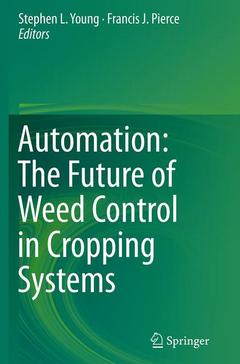Description
Automation: The Future of Weed Control in Cropping Systems, Softcover reprint of the original 1st ed. 2014
The Future of Weed Control in Cropping Systems
Coordinators: Young Stephen L., Pierce Francis J.
Language: English
Subjects for Automation: The Future of Weed Control in Cropping Systems:
Keywords
Publication date: 09-2016
Support: Print on demand
Publication date: 12-2013
265 p. · 15.5x23.5 cm · Hardback
Description
/li>Contents
/li>Comment
/li>
Forward; Simon Blackmore.- Preface; Stephen L. Young.- Acknowledgements.- Introduction: Scope of the Problem – Rising Costs and Demand for Environmental.- Safety for Weed Control; Stephen L. Young, Francis J. Pierce, and Pete Nowak.- Part I Agricultural Production Systems.- Current State of Organic and Conventional Cropping Systems; Alec F. McErlich and Rick A. Boydston.- Part II Principles and Merging of Engineering and Weed Science.- Engineering Advancements; John K. Schueller.- Plant Morphology and the Critical Period of Weed Control; J. Anita Dille.- The Biological Engineer: Sensing the Difference between Crops and Weeds; David C. Slaughter.- Part III Primary Weed Control Tools for Automation.- Precision Planting and Crop Thinning; Scott A. Shearer and Santosh K. Pitla.- Automated Mechanical Weeding; M. Taufik Ahmad, Lie Tang, and Brian L. Steward.- Targeted and Micro-Dose Chemical Applications; Stephen L. Young and D. Ken Giles.- Part IV Field Applications.- Field Applications of Automated Weed Control: Western Hemisphere; Steven A. Fennimore, Bradley D. Hanson, Lynn M. Sosnoskie, Jayesh B. Samtani, Avishek Datta, Stevan Z. Knezevic, and Mark C. Siemens.- Field Applications of Automated Weed Control: Northwest Europe; Jan Willem Hofstee and Ard T. Nieuwenhuizen.- Field Applications of Automated Weed Control: Asia; Hiroshi Okamoto, Yumiko Suzuki, and Noboru Noguchi.- Part V Economies for Automated Weed Control.- Economics of Technology for Precision Weed Control in Conventional and Organic Systems; Florian Diekmann and Marvin T. Batte.- Future Adoption of Automation in Weed Control; Josse De Baerdemaeker.- Automation for Weed Control in Least Developing Countries (LDCs); Renan Aguero, Noel M. Estwick, and Edgar Gutierrez.- Part VI Future Directions.- Future Directions for Automated Weed Management inPrecision Agriculture; Stephen L. Young, George E. Meyer, Wayne Woldt.- Appendix.- Glossary.- Index.
These books may interest you

Recent Advances in Weed Management 158.24 €



